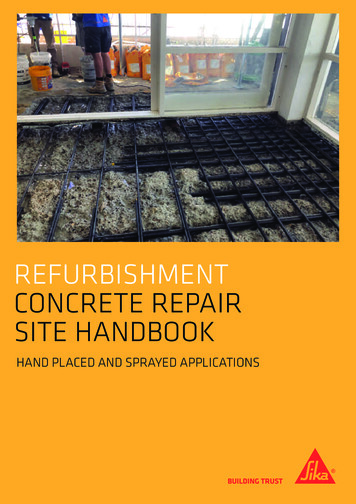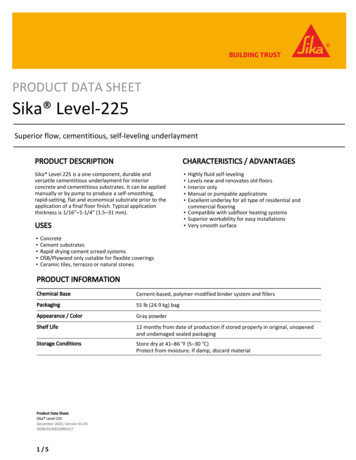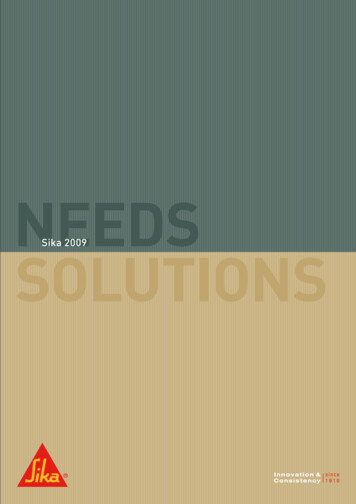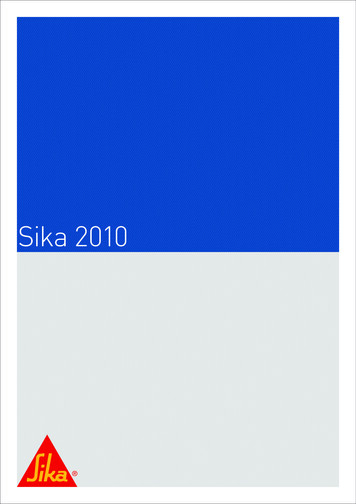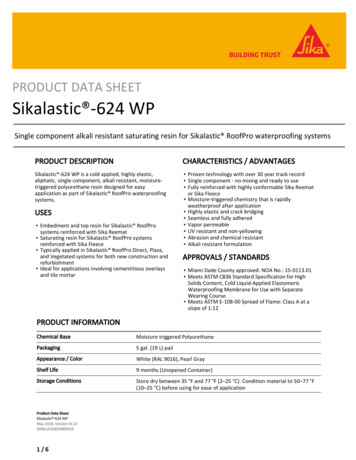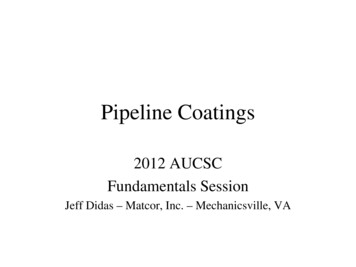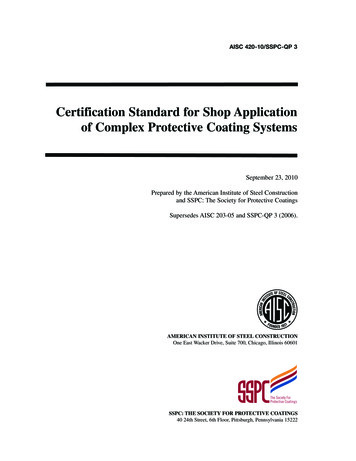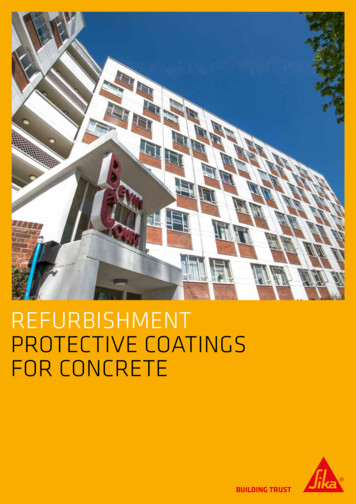
Transcription
REFURBISHMENTPROTECTIVE COATINGSFOR CONCRETE
SIKA – YOUR PARTNERConcrete is a material especially used in civil engineering structures for its strength and durability.For buildings it also has to achieve the look and beauty envisaged by the owner and their architect.To enhance these aesthetics and bring more colors, or for example to increase the durability of theconcrete by preventing water ingress and to seal and accommodate surface cracks, protectivecoating systems can provide the ideal solution.We have developed and produced coating systems that are used all around the world to protectconcrete surfaces and structures for many decades. This includes the protection of all types ofbuildings and structures, in various types of environment and climatic conditions, from the wintercold of North America and Eastern Europe, the heat and humidity of Central and Southern Americaor Asia, to the dry, arid heat of the Middle East and desert regions.2REFURBISHMENTPROTECTIVE COATINGS FOR CONCRETE
CONTENTS04Sika’s Life Cycle Assessment Approach05Sustainable Refurbishment of Cooling Towers08Proven Long-Term Durability10Concrete Structures and their Exposure12Key Stages in the Concrete Refurbishment Process13Sika Principles in Accordance with European Standard EN 150414Assessment of Typical Causes and Effects of Damage16Concrete Refurbishment Strategy17General Concrete Refurbishment Procedures18Refurbishment Process22Key Parameters for Selection of the Concrete Protection System24Barrier to Carbon Dioxide26Sika Organic Coating28Sika Cement Based Coating30Sika Reactive Coatings32Sika Product Selection Guide34Case StudiesREFURBISHMENTPROTECTIVE COATINGS FOR CONCRETE3
SIKA’S LIFE CYCLE ASSESSMENTAPPROACHterialsRaw maWasteCradle to GateEnd-oflifeSika carries out LCAs according to the ISO 14040 series andthe Standard EN 15804. The impact assessment methodologyused is CML 2001. The data for the Sika LCA is based on publicdatabases, such as those from ecoinvent, the European Reference Life Cycle Database (ELCD) and PE-GaBi, plus the specificdata from Sika production plants and products.Natural resourcesProductionLife Cycle Assessment (LCA) is a standardized method to assess and compare the inputs, outputs and potential environmental impacts of products and services over their life cycle.LCAs are increasingly recognized as the best way to evaluatethe sustainability of products and systems.Cradle to GraveUseand maintenancelicAppa tionSika evaluates all impact categories and resource indicatorsdeemed as important according to the relevant standards.Cumulative Energy Demand (CED), Global Warming Potential(GWP) and Photochemical Ozone Creation Potential (POCP)are considered to be most relevant for concrete repair andprotection:́́ Cumulative Energy Demand (CED) is the total amount of primary energy from renewable and non-renewable resources.4REFURBISHMENTPROTECTIVE COATINGS FOR CONCRETÉ́ Global Warming Potential (GWP) is the potential contributionto climate change due to greenhouse gases emissions.́́ Photochemical Ozone Creation Potential (POCP) is the potential contribution to summer smog, related to ozone inducedby sunlight on volatile organic compounds (VOC) and nitrousoxides (NOx).
SUSTAINABLE REFURBISHMENTOF COOLING TOWERSSika LCAs on refurbishment strategies for cooling towersare based on a ‘Cradle to Grave’ approach. Potential environmental impact of products for concrete repair and protectionare investigated from raw material extraction, production, application and use to final disposal at end of life. Constructionand end-of-life scenario of the reinforced concrete structureitself are excluded.Natural Draft Cooling Tower Refurbishment Scenarios 20’000 m² cenario 1SCost orientatedScenario 2Retrofitting with durable systemScenario 3Durability orientatedInitial construction No protectionNo protectionFull protection with proven coatingand adequate surface preparationAfter 20 years Full refurbishmentInadequate surface preparationhighly solvented coatingsFull refurbishmentproper surface preparationproven protective coatingsRefreshing coat onlyEvery 10 yearsFull refurbishment as after 20 years No requirementEvery 20 yearsRefreshing coat onlyNo requirementRefreshing coat onlyREFURBISHMENTPROTECTIVE COATINGS FOR CONCRETE5
SUSTAINABLE REFURBISHMENTOF COOLING TOWERSSika’s well proven and durable protective system(scenarios 2 & 3) allows a reduction in the frequency of refurbishment while having a significant reduction on the threeimpact categories and a lower material input.Advantages of scenario 3 over scenario 2 is the better flexibility for correct application of the protection system at thetime when the tower is erected.Scenario 1: Polymer modified cement protective coating system10 years20 yearsNo Protection10 years10 years10 yearsFull refurbishment every 10 yearsScenario 2: Retrofitting with durable system20 years20 yearsNo Protection20 yearsFull RefurbishmentRefreshing coatScenario 3: Durability oriented system20 years20 yearsFull Protection20 yearsRefreshing coat every 20 yearsCumulative Energy Demand (CED)GJ/20’000 m2/60 yearskg Ethelyne-Eq./20’000 m²/60 yearsPhotochemical Ozone Creation Potential 06’0004’00050002’0000Scenario 1Cost orientatedRepairProtection outer shellScenario 3Scenario 2Durability orientatedResurfacingRefreshing inner shellProtection inner shellRefreshing outer shellThe higher impact of scenario 1 is due to the use of heavilysolvent containing coating system.The difference between the scenario 1 and the other two isaround 20’000 liters of Ethylene equivalent over the life cycleperiod of 60 years. This is equivalent to a saving of more than one drum ofpure solvent a year.6REFURBISHMENTPROTECTIVE COATINGS FOR CONCRETE0Scenario 1Cost orientatedRepairProtection outer shellScenario 3Scenario 2Durability orientatedResurfacingRefreshing inner shellProtection inner shellRefreshing outer shellScenarios 2 and 3 have significant lower CED than scenario1. This is due to a greater resource efficiency (lower materialconsumption over the whole life cycle). This is equivalent to a saving of 1’300 liter of oil per year.
CONCLUSIONtonnes CO2 eq./20’000 m2/60 yearsGlobal Warming Potential (GWP)1’200Overall savings for the plant owner with positive incidence onsustainability:1’000The appropriate strategy can have a beneficial impact:́́ by reducing the frequency of refurbishment cycleś́ by improving the resource efficiency and the environmentalperformance of the refurbishment procesś́ by providing a more sustainable solution8006004002000Scenario 1Cost orientatedRepairProtection outer shellScenario 2Scenario 3Durability orientatedResurfacingRefreshing inner shellProtection inner shellRefreshing outer shellThe greater resource efficiency of scenario 2 and 3 allowssaving of 600 tons of CO over the life cycle of 60 years.² This is equivalent to a saving of 77’000 km a year(compared to the limit of the European Union of not morethan 130 g of CO per km targeted for 2015).²REFURBISHMENTPROTECTIVE COATINGS FOR CONCRETE7
PROVEN LONG-TERM DURABILITYSIKA PROTECTIVE COATINGS have been applied all over the world for several decades.Extensive references and Case Studies are available for all types of structures and exposures.In the late 1990’s Sika commissioned various external institutes to investigate the performance of Sika concrete repairand protection systems that had been applied some yearsbefore. This in-depth investigation was carried out in Europe(England, Germany, Denmark and Norway), and revealed theoutstanding performance of the different Sika protectivecoatings that had been applied from 10 to 20 years ago on thedifferent projects.In 2008, a similar investigation was made into the performance of the protective coating systems applied 16 years agoat that time, on multiple Cooling Towers of a power plant inPoland. This revealed that despite the harsh conditions, bothinternally and externally the Sika protective coating systemsstill achieved, and even still outperformed, the protectiveperformance requirements of the latest European StandardEN 1504-2.It is therefore also no surprise that Sika won more than 100awards from the prestigious ICRI institute, for projects successfully completed and having proven durability using SikaConcrete Repair and Protection Systems. Among them manyICRI awards of longevity were won when using Sika protectivecoatings.REFURBISHMENTICRI AWARD-WINNINGPROJECTS 1998 – 2013SIKA – STRIVING FOR EXCELLENCE IN CONCRETE REFURBISHMENTTECHNICAL ARTICLEAlbert Barnes House, London, UKOriginal Constsruction: 1963, Concrete Repair and Protection: 1982, Inspection and Assessment: 1997MARCH 2016 / VERSION 3 / SIKA SERVICES AG / MICHEL DONADIOFOR EXTERNAL DIFFUSIONSIKA AT WORKTURÓW POWER PLANT,POLANDCONCRETE REPAIR:Sika MonoTop System, Sikacrete PP1 TUPROTECTIV COATINGS: Sikagard -700, Sikagard -680 S,Sikagard -550 W Elastic,Sika Poxicolor, Sika Icosit-2406,SikaCor EG 58REFURBISHMENTPROTECTIVE COATINGS FOR CONCRETETECHNICAL ARTICLETECHNICAL ARTICLECONCRETE BRIDGES IN JUTLAND, DENMARKTHE LÄMERSHAGEN BRIDGE A2 MOTORWAY, GERMANYSEPT‐2013 / V‐2 / SIKA SERVICES AG / MICHEL DONADIOMAY 2014 / V-2 / SIKA SERVICES AG / MICHEL DONADIOFOR EXTERNAL DIFFUSIONFOR EXTERNAL DIFFUSIONOriginal Construction: 1960’s, Concrete Repair and Protection: 1983,Inspection and Assessment: 1988, 1991 and 1994Original Construction: Late 1940’s, Concrete Repair and Protection: 1981-82,Inspection and Assessment: 1997
CONCRETE STRUCTURESAND THEIR EXPOSUREDEPENDENT ON THEIR LOCATION AND USE, concrete structures are subjected to a wide range ofexposure conditions – from normal atmospheric carbonation to the aggressive influences in pollutedurban and/or industrial environments, plus marine atmospheres and other chemicals (liquid andgaseous) etc., together with other influences and actions that can damage or attack the concreteand / or its embedded steel reinforcement.Water IngressWater can penetrate naturally through the capillarypore structures of reinforced concrete. In areas ofcarbonated concrete, or where there is a high chloridecontent on the surface of the steel reinforcing bars,reinforcement corrosion, cracks or spalling can occuron the surface.Freeze / Thaw ActionThe freeze thaw process creates stresses in theconcrete matrix due to the expansion of free waterin the capillary pores during freezing conditions; thiscan result in scaling of the surface of poor qualityconcrete. This action is also greatly accelerated bythe presence of chlorides in the water.Dynamic and Static LoadOverloading due to increasing traffic loads, inadequate design, damage to the structure, stress/fatigue failure, earthquake effects, or any other mechanical impact such as vehicle impact, can allexceed or reduce the load capacity of the structure.ChemicalSome structures such chemical plants or sewer system or waste water treatment plants are subjectedto different level of chemical attacks. Some specialcoatings may be required – refer to the relevant Sikabrochure.Wide Temperature VariationBuildings and bridges may be subjected to a widevariation of temperatures between day and night /winter and summer conditions, or between differentsides or surfaces of the structure. These frequentcycles result in thermal stresses and movement inthe concrete structure that can also result in cracks.FireReinforced concrete may be damaged from fire exposure. Special intumescent coatings may be usedto protect against the structures against the effectof fire. What is expected from normal coating is theyshould not bring food to the fire in order not to increase its intensity. Some structures like tunnel havespecial consideration with this particular risk.Carbon DioxideCarbon Dioxide (CO ) reacts with the Calcium Hydrox²ide (Ca(OH) ) in the pore liquid of the cement matrix²of concrete structures and deposits as calcium carbonate (CaCO ). This process known as carbonation³reduces the protection of embedded steel reinforcement, when the process reaches the reinforcementbars.Chlorides IngressChlorides come from de-icing salts used in winter, orfrom salt water in marine environments. They canpenetrate the concrete structure and once they reachthe reinforcement bars, they can locally destroy thepassivation film causing fast pitting corrosion.10REFURBISHMENTPROTECTIVE COATINGS FOR CONCRETE
REFURBISHMENTPROTECTIVE COATINGS FOR CONCRETE11
KEY STAGES IN THE CONCRETEREFURBISHMENT PROCESSTHE SUCCESSFUL REPAIR, PROTECTION AND CORROSION MANAGEMENT of concretestructures always requires an initial professional assessment and an appropriate detailedcondition survey.KEY STAGES IN THE CORRECT REPAIR AND REFURBISHMENT PROCESS:1. ASSESSMENT OF THE STRUCTUREA condition survey by qualified and experienced people to include the condition of the structure and its surfaces, includingvisible, non-visible and potential defects.2. IDENTIFICATION AND DEGREE OF THE CAUSE(S)OF DAMAGEA review of the original construction details and any previousrefurbishment works, plus analysis and diagnosis from thecondition survey to identify:́́ Damage due to concrete defects or attack (mechanical,chemical or physical types)́́ Damage due to reinforcement corrosion (carbonation orchloride attack)3. DETERMINATION OF REPAIR AND PROTECTIONOBJECTIVES AND OPTIONSOwners and engineers always have a number of options fordeciding the appropriate refurbishment strategy to meet thefuture requirements of the structure.4. SELECTION OF APPROPRIATE REPAIR PRINCIPLESAND METHODSIn accordance with EN 1504-9 the appropriate “repair principles” should be selected and then the best “method” ofachieving each principle can be defined.Following this selection, the performance requirements ofsuitable products are defined, using European Standards EN1504 Parts 2 to 7 in conjunction with Part 10, which also provides guidelines for the work preparation and site applicationincluding quality control. On these substantial structures withtheir very specific exposure and damage potential, the materials selected must also be tested and proven in these veryspecific conditions.5. FUTURE MAINTENANCEAs with all refurbishment projects, the need and likely timeschedule for future inspection and maintenance should bedefined. Complete and fully detailed records of the works undertaken must always be maintained.
SIKA PRINCIPLES IN ACCORDANCEWITH EUROPEAN STANDARDEN 1504SIKA IS THE GLOBAL MARKET AND TECHNOLOGY LEADER in research, development andproduction of concrete repair systems for all types of buildings and civil engineering structures.For every owner or consultant, their own project, building orstructure is always the most important. Sika is the ideal partner for owners and their architects, engineers, contractors andaccess equipment suppliers focused on these works, whateverthe type, sizes and age of the structure.Extensive independent testing with all relevant approvals andcertificates, supported by an equally extensive portfolio ofsuccessfully completed case studies and reference projectsaround the world, provides maximum confidence and securityfor everyone involved in the project.All of the products and systems required for the successfulrepair and protectionof the concrete structure, including all ofthe exposed surfaces are produced by Sika and fully in accordance with European Standards EN 1504. This includes gradesof the materials developed for application in all of the differentexposure and climatic conditions that can be encountered allover the world.Whatever damage has occurred, whatever the future exposure requirements are, and wherever the location – Sika is theideal partner for your project.Sika also provides a complete package of documentation to assist all of our partners with the selection of the most appropriate concrete repair and protection principles and methods, thenecessary detailed specifications and tender documents, pluscomplete integrated Method Statements for the correct use ofall of the products and systems. Then Sika’s Technical ServicesDepartment will train your engineers and contractors in theQuality Controlled use and application of the products both offand on site.
ASSESSMENT OF TYPICAL CAUSESAND EFFECTS OF DAMAGEDAMAGE DUE TO CONCRETE DEFECTS OR ATTACKCHEMICAĹ́ Aggressive exhaust gaseś́ Condensation leachinǵ́ Waste wateŕ́ Chemical spillageSevere detoriation of concrete and corrosion of reinforcing steel despite a previously applied unadequate coating in the internal face of acooling tower.PHYSICAĹ́ Thermal movementcrackinǵ́ Adverse thermal gradientcrackinǵ́ Freeze/thaw actioń́ Shrinkage (from hydration)́́ ErosionChimneys in direct sunlight indicating variations in thermal exposure which are further exacerbated by the effects of the downward flow ofhot exhaust gases during periods of temperature inversions.14REFURBISHMENTPROTECTIVE COATINGS FOR CONCRETE
DAMAGE DUE TO STEEL REINFORCEMENT CORROSIONCARBONATIONAtmospheric carbon dioxideingress (loss of alkaline protection).Ca(OH) CO CaCO H O²²³²Carbon dioxide from theatmosphere penetrates progressively into the concreteand reacts with the calciumhydroxide in the pore liquid.This eventually reduces theprotective alkalinity aroundthe steel, allowing corrosionto start in presence of water.This phenomenon is oftenassociates with low concretecover.General corrosion induced by carbonation aggravated with low concrete cover issue.CHLORIDESDependent on their locationand use (e.g. bridges or buildings and structures near thesea), corrosion of the reinforcement can also occur dueto attack from chlorides inmarine atmospheres or fromde-icing salts (e.g. bridgepiers on roads in northernEurope).Reinforcing steel corrosion in a pier.REFURBISHMENTPROTECTIVE COATINGS FOR CONCRETE15
CONCRETE REFURBISHMENTSTRATEGYIN THE 21ST CENTURY, REINFORCED CONCRETE STRUCTURES ARE BUILT TO LAST(e.g. most bridges are now designed to last more than 100 – 150 years). The two most universalcauses of reinforcement corrosion and concrete damage are carbonation and chloride attack.The faster carbon dioxide or chlorides penetrate the concrete,the sooner the passive layer around the reinforcement bars isdestroyed and the corrosion process initiated.To ensure long lasting durability, an appropriate maintenance16REFURBISHMENTPROTECTIVE COATINGS FOR CONCRETEstrategy should also be followed by the owners and their construction management. Protective coatings can be an important part of this strategy, to ensure a long service-life for newstructures and also to increase the durability of existing ones.
GENERAL CONCRETEREFURBISHMENT PROCEDURESTHE REPAIR AND PROTECTION OF CONCRETE STRUCTURES must always be executed accordingto all relevant local Standards and Regulations.After a detailed condition survey and root cause analysis, theright procedures for successful refurbishment can be defined.Standards (such as European Standard EN 1504-9) defineprinciples and methods to refurbish damaged concrete. Pleaserefer to our Brochure “The Repair and Protection of ReinforcedConcrete with Sika” for more information relating to repair andprotection according to EN 1504.Types of Damage/Defects (Examples)Possible Principles/Methods EN 1504-9For the RepairFor the ProtectionConcrete spalling/scaling of concretesurfacePrinciple 3:Concrete restoration(Method 3.1/3.2/3.3)Principle 1:Protection against ingress(Methods 1.1/1.2/1.3)Principle 5:Physical resistance (Method 5.1/5.2/5.3)SteelreinforcementcorrosionPrinciple 7:Restoring passivity(Method 7.1/7.2)Principle 8: Increasing resistivity (Method 8.1/8.2/8.3)Principle 9:Cathodic control (Method 9.1)Principle 10:Cathodic protection (Method 10.1)Control of anodic areas (Methods11.1/11.2/11.3)Structural cracksConcrete restoration(Methods 3.1/3.3)Crack Injection(Methods 4.5/4.6)Structural strengthening(Methods 4.1/4.3/4.4/4.7)Not applicableNon-structuralcracksPrinciple 1:Filling of cracks(Method 1.5)Principle 1:Protection against ingress (Method1.1/1.2/1.3)Principle 2:Moisture control (Method 2.1/2.2/2.3)Principle 5:Physical resistance (Methods 5.1/5.2/5.3)Chemical attacksPrinciple 6:Adding mortar or concrete(Method 6.3)Principle 6:Resistance to chemicals with coating(Method 6.1)Not treated in this document – refer to SikaWaste Water Treatment Plant brochureREFURBISHMENTPROTECTIVE COATINGS FOR CONCRETE17
REFURBISHMENT PROCESSTHE FIRST STAGE OF THE REPAIR WORK ITSELF ON SITE is usually to remove the damagedconcrete and then to clean any exposed steel reinforcement.Any exposed steel reinforcement should be cleaned to removerust and corrosion products. EN 1504 Part 10 recommends thesteel be prepared to Sa 2½ (if a barrier coating is to be applied)or to Sa 2 (if an active protective coating is to be applied) according to the classification in ISO 8501-1.This cleaning and preparatory work should all be carried out inaccordance with the site works and application guidelines ofEN 1504 Part 10 Section 7.EXPOSED STEEL PROTECTIONSika has several products for this purpose; all using active corrosion inhibitors. The selection of the most appropriate product is dependent on the environmental exposure level:́́ For normal environments (e.g. typical urban atmosphere):Sika MonoTop -910 one-component, cement based, activecorrosion protection is used,.́́ For aggressive environments (e.g. marine, chemical, sewage,etc.): SikaTop Armatec -110 EpoCem epoxy modified, cement based, active corrosion protection is used.These products with EN 1504 Part 9 Principle 11 Control ofanodic areas: Method 11.1 Painting reinforcement with activecoatings also comply with EN1504 Part 7 reinforcement corrosion protection.EMBEDDED STEELAdditional protection can also be provided to steel that is notactually exposed, but is at risk of corroding, i.e. in carbonated18REFURBISHMENTPROTECTIVE COATINGS FOR CONCRETEconcrete. This is done by the application of Sika FerroGard corrosion inhibitors.Sika FerroGard corrosion inhibitors are based on amino-alcohol or nitrite technology.Amino-alcohol materials form a mono-molecular passivatingfilm or barrier layer over the surface of the steel, whilst nitritebased materials help to oxidize the steel and form ferric oxide,which resists chloride attack. These Sika FerroGard corrosion inhibitors can be applied at the surface or mixed withinthe concrete:́́ Surface applied inhibitor: Sika FerroGard -903 Plus (Aminoalcohol based).́́ Mixed in the concrete: Sika FerroGard -901 S (amino-alcoholbased) or Sika FerroGard-910 CNI (nitrite based).This technique conforms with EN 1504-9 Principle 11 Control ofAnodic Areas, Method 11.3 Applying corrosion inhibitors in, orto the concrete, but currently there is no harmonized performance standard available.The use of deep penetrating hydrophobic impregnations isalso a proven and efficient technology to mitigate corrosion incarbonated concrete or in chloride environment.This technique conforms with EN 1504-9 Principle 8 IncreasingResistivity, Method 8.1 hydrophobic impregnation.These products shall comply with highest requirements of EN1504-2.
Sika MonoTop CONCRETE REPAIRMORTAR SYSTEMSIKA PRODUCES A COMPLETE RANGE OF REPAIR MORTARS AND MICRO CONCRETES, whichare specifically designed for restoring or replacing the original profile and function of the damagedconcrete, with grades suitable for all types of structures (buildings, cooling towers, bridges, WWTplants etc.).These include cement-bound, polymer modified, cementbased and epoxy resin based products, for selection accordingto the specific project application and performance requirements.All of these repair materials are in accordance with EN 1504-9Principle 3 (CR) Concrete Restoration and comply withEN 1504-3. The class of mortar to be used is generally determined in relation to the nature and function of the concrete inthe structure.Repair materials can be applied using different applicationtechniques. For each different application technique, there arecorrespondingly different products available.Sika MonoTop CONCRETE REPAIR MORTAR SYSTEM1Reinforcement CorrosionProtectioń́ To prevent further corrosionof steel reinforcement2Bonding Primeŕ́ To promote adhesion of therepair mortar on demandingsubstrates1233Repair Mortaŕ́ To repair concrete defectś́ To restore structural integritý́ To improve durabilitý́ To improve appearancé́ To extend the structure’sdesign life4420REFURBISHMENTPROTECTIVE COATINGS FOR CONCRETEPore Sealer / Levelling Mortaŕ́ To restore durabilitý́ To restore aesthetic appearancé́ To restore geometric appearancé́ To provide a surface for overcoating
Sika MonoTop RANGE FOR COST-EFFECTIVE SOLUTIONSRequirementMain featuresProductsMulti-functional productsProducts for normal and demanding applications: 2 in 1 Bonding Primer & Reinforcement CorrosionProtectioń́ Sika MonoTop -910 Noŕ́ SikaTop Armatec -110EpoCem Durable and long-lasting repairmortarsIncreased performances above standard requirements: Successfully tested with 400 freeze and thaw cycles Increase sulfate resistance Low chloride diffusioń́ Sika MonoTop -412 NFG /-SFGReduce the number of application steps3 in 1 product solution Improved fresh adhesion – bonding primer not required Corrosion inhibitor – no reinforcement corrosion protection Smooth finishing – no levelling mortar necessarý́ Sika MonoTop -412 NFG /-SFGoŕ́ Sika MonoTop -352 NFG /-SFGMinimizing transport disruptionand closuresA new application system: Successfully tested under live dynamic loadinǵ́ Sika MonoTop -412 N /-Swith́́ SikaTop Armatec -110EpoCem Value for moneyA better yield from each bag: Low density lightweight mortarś́ Sika MonoTop -352 NFG /-SFGoŕ́ Sika MonoTop -352 N /-SFast over-coating within onedayComplete system compatibility: Proven & tested with thin film coatingś́ Sika MonoTop -211 RFG /-FGand́́ Sikagard -675 WSika MonoTop -723 N: resurfacing mortar for hand and spray application.REFURBISHMENTPROTECTIVE COATINGS FOR CONCRETE21
KEY PARAMETERS FOR SELECTIONOF THE CONCRETE PROTECTIONSYSTEM“ACCORDING TO THE EXPOSURE CONDITIONS (e.g. marine or urban environment, resistance tofreeze-thaw etc.), and the requirements of the owner in terms of aesthetics and durability etc., theresponsible design consultant can determine and specify consider the characteristics of the protective coating system to be used.”For protective coatings, the only global standard that coversthis range of product is the EN 1504-2. An example of the keycriteria for the protective coating product/system selectionPrinciplesand based on this European Standard is given in the tablebelow (as table 1 of EN lIncreasingPhysicalResistanceResistance Increasingto chemicals resistivityTest methodsPerformance Characteristics1.3 (C)2.3 (C)5.1 (C)6.1 (C)8.3 (C)EN 12617-1Linear shrinkage EN 12190Compressive strength EN 1770Coefficient of thermal expansion EN ISO 5470-1Abrasion resistance EN ISO 2409Adhesion by cross-cut test EN 1062-6Permeability to CO EN ISO 7783-1EN ISO 7783-2Permeability to water vapour Capillary absorption and permeabilityto water EN 1062-3² Adhesion after thermal compatibilityEN 13687-1Freeze-thaw cycling with de-icing saltimmersion EN 13687-2Thunder-shower cycling (thermal shock) EN 13687-3Thermal cycling without de-icing saltimpact EN 1062-11:2002 4.1: Ageing: 7 days at 70 C EN 13687-5Resistance to thermal shock EN 1062-11:2002 4.2: Behaviour after artificialweathering EN ISO 2812-1 Chemical resistanceEN 13529Resistance to severe chemical attackEN 1062-7Crack bridging abilityEN ISO 6272-1Impact resistanceEN 1542EN 13501-122 Adhesion strength by pull-off test Fire classification of construction products and building elementsPart 1: Classification using test datafrom reaction to fire test EN 13036-4Slip/skid resistanceEN 13578Adhesion on wet concreteKey: Characteristic for all intended usesREFURBISHMENTPROTECTIVE COATINGS FOR CONCRETE Characteristic for certain intended uses within the scope of EN 1504-9:2008
BARRIER TO CARBON DIOXIDEONE OF THE MOST IMPORTANT PROPERTIES OF A PROTECTIVE COATING ON CONCRETEstructures is its ability to prevent or significantly reduce the diffusion of carbon dioxide (CO ) into the²concrete.If CO penetrates the concrete, it will react with free lime²present as calcium hydroxide in the pore liquid, which produces insoluble calcium carbonate and reduces the protective alkalinity (pH level) of the concrete. This natural processis known as carbonation and it progresses inwards from thesurface over time.When the carbonation front reaches the level of the reinforcement, the steel bars are no longer in a passive environmentdue to the loss of protective alkalinity, and if oxygen andmoisture are present, then the steel bars will start to corrode.Therefore an effective protective coating for concrete mustprevent or very significantly reduce diffusion of CO into the²concrete. The European Standard EN 1504-2 places a minimumthreshold for this as being equivalent to a 50 m barrier of air.One of the founders of this test method, Dr.-Ing. RobertEngelfried, in a paper published in New Orleans in 1996 (ICRIInternational Concrete Repair Institute Annual Meeting) clearly demonstrates that this 50 meter threshold provides a sufficiently effective long term barrier protection to be regardedas completely stopping the progression of carbonation.Carbonation depth in mmNo protection12108SD 1,2 m64SD 50 mSD 32Square root of time0014916Evolution of carbonation depth over time when different coatings are being used:́́ No protectioń́ A basic decorative paint with no protection performance (SD 1.2 m)́́ A protective coating complying with the threshold of EN 1504-2 (SD 50 m) and́́ A complete stop of the carbonation progression (equivalent to an SD which has
3 REFURBISHMENT PROTECTIVE COATINGS FOR CONCRETE CONTENTS 04 Sika's Life Cycle Assessment Approach 05 Sustainable Refurbishment of Cooling Towers 08 Proven Long-Term Durability 10 Concrete Structures and their Exposure 12 Key Stages in the Concrete Refurbishment Process 13 Sika Principles in Accordance with European Standard EN 1504 14 Assessment of Typical Causes and Effects of Damage
